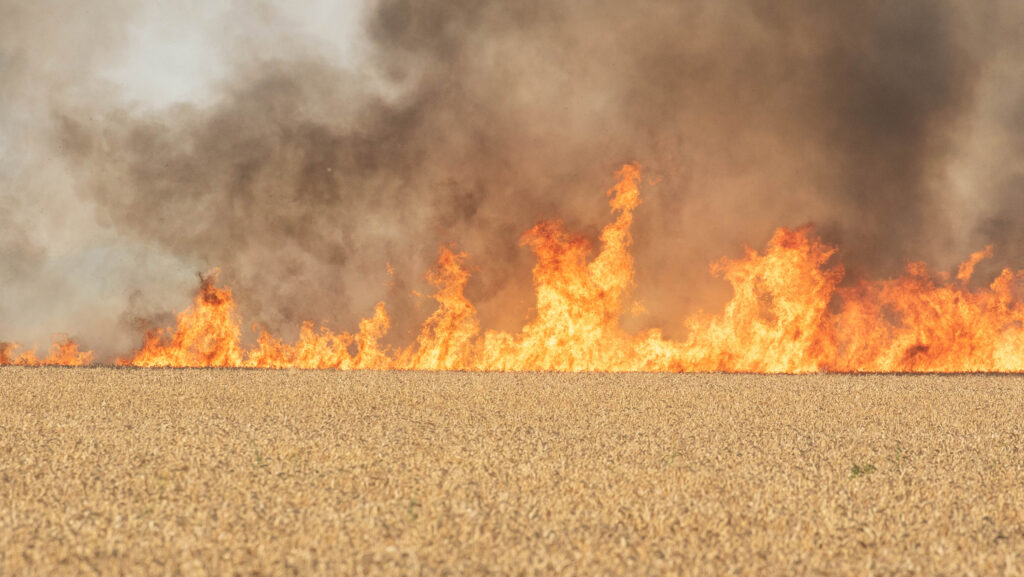Arson one of leading causes of UK farm fires
 © Tim Scrivener
© Tim Scrivener Arson has emerged as a leading cause of UK farm fires, according to a new NFU Mutual report.
The insurer estimates blazes destroying crops, buildings and equipment cost farmers £102m in 2024, with electrical faults and lightning strikes the other top triggers.
Selkirkshire farmer Nigel Miller experienced the impact first-hand after an arson attack last year forced him to rescue 30 cattle from a smoke-filled barn.
See also: Fire risk planning – what to consider on a livestock farm
A neighbour returning home late at night spotted the flames and helped Mr Miller and his son drive the cattle to safety.
“We were left with a mess of charred, sodden straw coated with shattered asbestos, which had to be removed by a specialist firm for safe disposal,” said Mr Miller.
“Having a fire on your farm leaves a mark on you and changes how you behave.
“For weeks, I kept going out to check the buildings every few minutes through the evenings and found it very difficult to go to bed before midnight.
“Eventually, I realised that for your own sake you have to try and put it behind you.”
The attack caused £28,000 worth of damage and was one of several suspected arson incidents in the Borders. Police made an arrest.
NFU Mutual also reports £37m in agricultural vehicle fire losses in 2024.
Last summer’s cooler, wetter weather and farmers holding on to older machinery may explain why combine harvester fire costs fell 52% to £3.5m.
This follows two years of far higher losses, at £11m and £7.4m.
In Norfolk, near Diss, farmer John Davie-Thornhill said only rapid action by firefighters stopped a crop fire from spreading to nearby homes.
“We think the fire was caused by the combine knife striking a flint which sparked, setting fire to the straw,” he said.
“It’s extraordinary how fast fire can spread across stubble – the conditions were dry but not exceptional, so we didn’t think there was a particularly high risk of fire compared to some extreme periods.”
Estimated regional farm fire claims costs reported to NFU Mutual |
|||
|
Area |
2023 cost |
2024 cost |
% cost change |
|
East |
£9.51m |
£9.52m |
+0.1% |
|
Midlands |
£12.7m |
£10.6m |
-16% |
|
North East |
£12.3m |
£16.4m |
+34% |
|
North West |
£28.9m |
£4.3m |
-85% |
|
Northern Ireland |
£5.2m |
£7.3m |
+42% |
|
Scotland |
£5.9m |
£11.8m |
+98% |
|
South East |
£9.4m |
£12.9m |
+36% |
|
South West |
£20.2m |
£24m |
+20% |
|
Wales |
£6.7m |
£4.8m |
-29% |
|
UK total |
£110.8m |
£102m |
-8% |
|
Notes: Figures rounded to the nearest £100,000. Percentage difference based on exact claims figures. The costs do not include agricultural vehicle fires. |
|||
NFU Mutual Risk Management Services farm fire prevention advice
- Have a plan in place Put people at the heart of your fire plan and ensure everyone on-site knows what to do in the event of a fire.
- Maintain your electrics Electrical faults are a major cause of farm fires, and electric shocks can cause death or severe injury. Don’t try and attempt electrical work yourself and always use a qualified and competent electrician for work and inspections.
- Suppress the risk Suppression systems play a critical role in detecting, containing and extinguishing fire. It may also be worth placing water bowsers in fields on hot days.
- Keep on top of housekeeping Good housekeeping is essential to ensure materials and machinery are stored correctly and helps to eliminate dust and debris.
- Control hot work Welding, cutting or grinding equipment, along with blowlamps and blow torches, produce sparks which can turn into fires if they hit combustible material. If work can’t be done outside, ensure you are in a clear, open area and far away from combustible materials (including combustible building structures).
